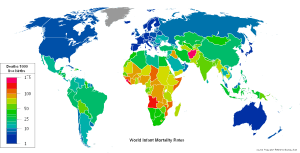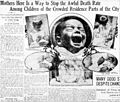Infant mortality facts for kids
Infant mortality is a way to measure how many babies pass away during their first year of life. It helps us understand the health of a community.
Contents
What is Infant Mortality?
Infant mortality means the death of a baby before they reach their first birthday. It is usually counted as the number of deaths for every 1,000 live births. This number helps us see how healthy babies are in different places.
For example, if a country has an infant mortality rate of 5, it means that for every 1,000 babies born alive, about 5 of them will not live to see their first birthday.
How is it Measured?
To find the infant mortality rate, you take the total number of babies who die before age one in a year. Then, you divide that by the total number of babies born alive in the same year. Finally, you multiply that number by 1,000.
Let's say in one year, 100 babies died before age one, and 20,000 babies were born alive.
- (100 deaths / 20,000 live births) * 1,000 = 5
So, the infant mortality rate would be 5.
Why is it Important?
The infant mortality rate is a very important number for understanding public health. A lower rate usually means that a country has good healthcare, clean water, and enough food for its people. It also shows that mothers and babies are getting the care they need.
When the rate is high, it can mean there are problems. These problems might include:
- Not enough doctors or hospitals.
- Lack of clean water or good food.
- Diseases that are not being treated.
- Poverty or inequality, where some families have much less than others.
Over the years, many countries have worked hard to lower their infant mortality rates. This has saved many lives and helped communities become healthier.
Global Differences
Infant mortality rates can be very different from one country to another. Countries with more resources and better healthcare systems often have lower rates. Poorer countries, or those facing challenges like conflict or natural disasters, often have higher rates.
For example, in 2009, the infant mortality rate in the USA was 6.8. This means about 6 or 7 babies out of every 1,000 did not live to their first birthday. In some other parts of the world, this rate can be much higher or much lower.
Images for kids
See also
 In Spanish: Mortalidad infantil para niños
In Spanish: Mortalidad infantil para niños








